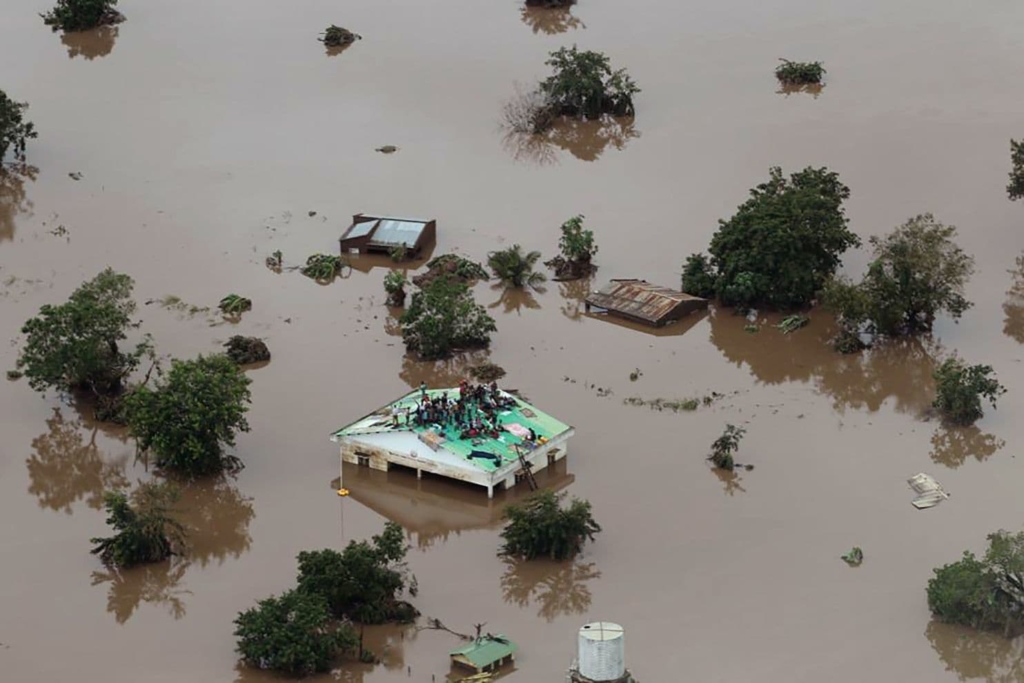Cyclone Idai could be the Southern Hemisphere’s deadliest storm – 2.6 million people in need of immediate aid, more than 1,000 feared dead – “Everything is destroyed, everything”

By Ishaan Tharoor
20 March 2019
(The Washington Post) – We don’t know how many people have died since Cyclone Idai made landfall last Thursday on the coast of Mozambique before barreling west into Zimbabwe and Malawi.
Aerial photography and drone footage have shown the apocalyptic scenes left in the cyclone’s wake: Fields of crops were ruined, rising floodwaters tore bridges off their moorings, mudslides smashed roads and whole villages were swept away. Survivors found themselves trapped on new “islands,” surrounded by the brackish waters that obliterated their homes.
The United Nations estimated that more than 2.6 million people are in need of immediate assistance. Aid officials believe the tropical storm damaged or destroyed some 90 percent of the Indian Ocean port of Beira, Mozambique’s fourth-largest city. Though the country’s authorities placed the official death toll at under 100 so far, President Filipe Nyusi spoke to local media after flying over affected areas in a helicopter and said that “everything indicates that we can have a record of more than 1,000 dead.” In Zimbabwe, the official death toll stood at 98; in Malawi, it’s at 56 — but the actual figures may take months to determine.
“The region affected by Idai is one of the poorest in the world,” wrote my colleague Max Bearak, who was en route to the ravaged city on Wednesday. “Infrastructure was already lacking, and the storm has destroyed key public institutions like hospitals and water sources.” Beira is a major entry point for food and gas inland; its paralysis raised fears of possible shortages across the region at a time when resources are already deeply strained.

Rescue efforts were hampered by collapsing infrastructure, poor telecommunications and heavy rains that continued through Tuesday. A giant storm surge, reported to be above 19 feet in some areas, transformed Beira — a city of half a million people — into a woeful waterworld, largely cut off from the rest of the country. According to the New York Times, the main highway into the city is impassable, while debris and toppled trees clog up other secondary roads.
“Everything is destroyed, everything,” said Deborah Nguyen, a World Food Program official, to The Post. “When I got here on Sunday, you could see the tops of palm trees in rural areas. Now it is just an inland ocean. The rain isn’t stopping anytime soon.” Her organization is nevertheless still attempting to airdrop food to stranded communities.
If the death tolls rise to the levels suggested by Nyusi and others, then Idai may prove an epochal event. “If these reports, these fears, are realized, then we can say that this is one of the worst weather-related disasters — tropical cyclone-related disasters — in the Southern Hemisphere,” Clare Nullis, a spokeswoman for the World Meteorological Organization, told reporters. [more]
Cyclone Idai could be the Southern Hemisphere’s deadliest storm

By Dr. Jeff Masters
18 March 2019
(Weather Underground) – An extreme humanitarian crisis is unfolding in Mozambique, where catastrophic Tropical Cyclone Idai made landfall on Thursday evening as a Category 2 storm with 110 mph winds. Mozambique president Filipe Nyusi told Mozambican radio on Monday that he had seen “many bodies” floating in the overflowing Pungwe and Busi rivers, and “it appears that we can register more than 1,000 deaths.”
Aerial survey images show that the coast of central Mozambique where Idai made landfall suffered severe damage from all three of the major hazards of a tropical cyclone: wind, storm surge, and flooding rains. As Idai approached the coast, the stronger left eyewall of the storm moved over Beira (population 530,000) near the time of high tide, driving a large storm surge into the city. Beira is Mozambique’s fourth largest city, and second largest port. The city is very low-lying, with portions lying below sea level. The city has no power, no communications, and flooded access roads, though the airport has some limited accessibility.
A list compiled Monday by AFP from official sources puts the death toll from Idai’s landfall in Mozambique at 68, including 55 in Beira alone. These deaths are in addition to the 66 deaths recorded in northern Mozambique the week before Idai’s landfall, due to flooding from the tropical disturbance that developed into Idai. Flooding from that disturbance also killed 56 people in Malawi. Cuamba, Mozambique received 11.14” of rain in just 12 hours on March 7 from the tropical disturbance that become Idai.

Zimbabwe: at least 98 dead
Idai brought up to a foot of rain to eastern portions of Zimbabwe near its border with Mozambique. The resulting floods have killed at least 98 people, with 217 missing and 102 injured, said government officials on Monday. Zimbabwe’s death toll from Idai is expected to rise, since the hardest-hit district of Chimanimani remains inaccessible due to damaged roads and main access bridges that have been washed away.
According to EM-DAT, this is the second deadliest flood on record for Zimbabwe. The deadliest was in January 2017, when 251 people died from flooding due to Tropical Cyclone Dineo. [more]
Tropical Cyclone Idai’s Death Toll in Mozambique May Exceed 1,000